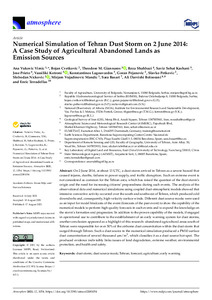Por favor, use este identificador para citar o enlazar este ítem:
http://hdl.handle.net/20.500.11765/13191
Numerical simulation of Tehran dust storm on 2 June 2014: a case study of agricultural abandoned lands as emission sources
| Título : | Numerical simulation of Tehran dust storm on 2 June 2014: a case study of agricultural abandoned lands as emission sources |
| Autor : | Vukovic Vimic, Ana; Cvetkovic, Bojan; Giannaros, Theodore M.; Shahbazi, Reza; Sehat Kashani, Saviz; Prieto Fernández, José Ignacio; Kotroni, Vassiliki; Lagouvardos, Konstantinos; Pejanovic, Goran; Petkovic, Slavko; Nickovic, Slodoban; Vujadinovic Mandic, Mirjam; Basart, Sara
 ; Darvishi Boloorani, Ali; Terradellas, Enric
; Darvishi Boloorani, Ali; Terradellas, Enric |
| Palabras clave : | Dust storm; Dust source mask; Forecast; Early warning |
| Fecha de publicación : | 2021 |
| Editor: | MDPI |
| Citación : | Atmosphere. 2021, 12(8), 1054 |
| Versión del editor: | https://doi.org/10.3390/atmos12081054 |
| Resumen : | On 2 June 2014, at about 13 UTC, a dust storm arrived in Tehran as a severe hazard that caused injures, deaths, failures in power supply, and traffic disruption. Such an extreme event is not considered as common for the Tehran area, which has raised the question of the dust storm’s origin and the need for increasing citizens’ preparedness during such events. The analysis of the observational data and numerical simulations using coupled dust-atmospheric models showed that intensive convective activity occurred over the south and southwest of Tehran, which produced cold downdrafts and, consequently, high-velocity surface winds. Different dust source masks were used as an input for model hindcasts of the event (forecasts of the past event) to show the capability of the numerical models to perform high-quality forecasts in such events and to expand the knowledge on the storm’s formation and progression. In addition to the proven capability of the models, if engaged in operational use to contribute to the establishment of an early warning system for dust storms, another conclusion appeared as a highlight of this research: abandoned agricultural areas south of Tehran were responsible for over 50% of the airborne dust concentration within the dust storm that surged through Tehran. Such a dust source in the numerical simulation produced a PM10 surface dust concentration of several thousand μm/m3, which classifies it as a dust source hot-spot. The produced evidence indivisibly links issues of land degradation, extreme weather, environmental protection, and health and safety. |
| URI : | http://hdl.handle.net/20.500.11765/13191 |
| ISSN : | 2073-4433 |
| Colecciones: | Artículos científicos 2019-2022 |
Ficheros en este ítem:
| Fichero | Descripción | Tamaño | Formato | ||
|---|---|---|---|---|---|
| atmosphere-12-01054.pdf | 12,08 MB | Adobe PDF |  Visualizar/Abrir |
Los ítems de Arcimis están protegidos por una Licencia Creative Commons, salvo que se indique lo contrario.





